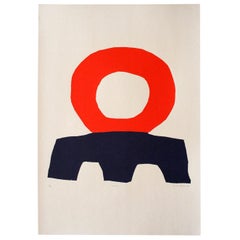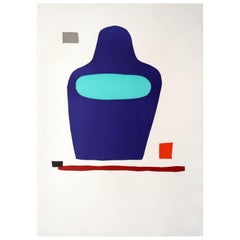Werner Graeff
Recent Sales
"SEROLOC" Original Bauhaus Artist Linocut Print, Signed Werner Graeff
By Werner Graeff
Located in Chicago, IL
editioned also in pencil by the artist's hand.
Werner Graeff (also Gräff), 24 August 24, 1901
Category
Mid-20th Century German Bauhaus Prints
Materials
Paper
"LIFLA" Original Bauhaus Artist Linocut Print, Signed Werner Graeff
By Werner Graeff
Located in Chicago, IL
also in pencil by the artist's hand.
Werner Graeff (also Gräff), 24 August 24, 1901, Wuppertal
Category
Mid-20th Century German Bauhaus Prints
Materials
Paper
"HALOC" Original Bauhaus Artist Linocut Print, Signed Werner Graeff
By Werner Graeff
Located in Chicago, IL
also in pencil by the artist's hand.
Werner Graeff (also Gräff), 24 August 24, 1901, Wuppertal
Category
Mid-20th Century German Bauhaus Prints
Materials
Paper
"Liblatur" Original Bauhaus Artist Linocut Print, Signed Werner Graeff
By Werner Graeff
Located in Chicago, IL
also in pencil by the artist's hand.
Werner Graeff (also Gräff), 24 August 24, 1901, Wuppertal
Category
Mid-20th Century German Bauhaus Prints
Materials
Paper
"Libru" Original Bauhaus Artist Linocut Print, Signed Werner Graeff
By Werner Graeff
Located in Chicago, IL
editioned also in pencil by the artist's hand.
Werner Graeff (also Gräff), 24 August 24, 1901
Category
Mid-20th Century German Bauhaus Prints
Materials
Paper
"SERTWISWABU" Original Bauhaus Artist Linocut Print, Signed Werner Graeff
By Werner Graeff
Located in Chicago, IL
editioned also in pencil by the artist's hand.
Werner Graeff (also Gräff), 24 August 24, 1901
Category
Mid-20th Century German Bauhaus Prints
Materials
Paper
H 25.5 in W 19.5 in D 0.01 in
"LIMEK" Original Bauhaus Artist Linocut Print, Signed Werner Graeff
By Werner Graeff
Located in Chicago, IL
also in pencil by the artist's hand.
Werner Graeff (also Gräff), 24 August 24, 1901, Wuppertal
Category
Mid-20th Century German Bauhaus Prints
Materials
Paper
"Sertwiswabu" Original Bauhaus Artist Linocut Print, Signed Werner Graeff
By Werner Graeff
Located in Chicago, IL
editioned also in pencil by the artist's hand.
Werner Graeff (also Gräff), 24 August 24, 1901
Category
Mid-20th Century German Bauhaus Prints
Materials
Paper
H 25.5 in W 19.5 in D 0.01 in
UNTITLED Original Bauhaus Artist Linocut Print, Signed Werner Graeff
By Werner Graeff
Located in Chicago, IL
also in pencil by the artist's hand.
Werner Graeff (also Gräff), 24 August 24, 1901, Wuppertal
Category
Mid-20th Century German Bauhaus Prints
Materials
Paper
"SERTWISWABU" Original Bauhaus Artist Linocut Print, Signed Werner Graeff
By Werner Graeff
Located in Chicago, IL
editioned also in pencil by the artist's hand.
Werner Graeff (also Gräff), 24 August 24, 1901
Category
Mid-20th Century German Bauhaus Prints
Materials
Paper
H 25.5 in W 19.5 in D 0.01 in
"Litwisto" Original Bauhaus Artist Linocut Print, Signed Werner Graeff
By Werner Graeff
Located in Chicago, IL
editioned also in pencil by the artist's hand.
Werner Graeff (also Gräff), 24 August 24, 1901
Category
Mid-20th Century German Bauhaus Prints
Materials
Paper
"LITWISTO" Original Bauhaus Artist Linocut Print, Signed Werner Graeff
By Werner Graeff
Located in Chicago, IL
editioned also in pencil by the artist's hand.
Werner Graeff (also Gräff), 24 August 24, 1901
Category
Mid-20th Century German Bauhaus Prints
Materials
Paper
"Litwisto" Original Bauhaus Artist Linocut Print, Signed Werner Graeff
By Werner Graeff
Located in Chicago, IL
editioned also in pencil by the artist's hand.
Werner Graeff (also Gräff), 24 August 24, 1901
Category
Mid-20th Century German Bauhaus Prints
Materials
Paper
"Liblatur" Original Bauhaus Artist Linocut Print, Signed Werner Graeff
By Werner Graeff
Located in Chicago, IL
also in pencil by the artist's hand.
Werner Graeff (also Gräff), 24 August 24, 1901, Wuppertal
Category
Mid-20th Century German Bauhaus Prints
Materials
Paper
"LITWISTO" Original Bauhaus Artist Linocut Print, Signed Werner Graeff
By Werner Graeff
Located in Chicago, IL
editioned also in pencil by the artist's hand.
Werner Graeff (also Gräff), 24 August 24, 1901
Category
Mid-20th Century German Bauhaus Prints
Materials
Paper
"LIFLA" Original Bauhaus Artist Linocut Print, Signed Werner Graeff
By Werner Graeff
Located in Chicago, IL
also in pencil by the artist's hand.
Werner Graeff (also Gräff), 24 August 24, 1901, Wuppertal
Category
Mid-20th Century German Bauhaus Prints
Materials
Paper
"Seroloc" Original Bauhaus Artist Linocut Print, Signed Werner Graeff
By Werner Graeff
Located in Chicago, IL
also in pencil by the artist's hand.
Werner Graeff (also Gräff), 24 August 24, 1901, Wuppertal
Category
Mid-20th Century German Bauhaus Prints
Materials
Paper
"LIFAR 6" Original Bauhaus Artist Linocut Print, Signed Werner Graeff
By Werner Graeff
Located in Chicago, IL
also in pencil by the artist's hand.
Werner Graeff (also Gräff), 24 August 24, 1901, Wuppertal
Category
Mid-20th Century German Bauhaus Prints
Materials
Paper
"Lifar 6" Original Bauhaus Artist Linocut Print, Signed Werner Graeff
By Werner Graeff
Located in Chicago, IL
editioned also in pencil by the artist's hand.
Werner Graeff (also Gräff), 24 August 24, 1901
Category
Mid-20th Century German Bauhaus Prints
Materials
Paper
"Lifar 6" Original Bauhaus Artist Linocut Print, Signed Werner Graeff
By Werner Graeff
Located in Chicago, IL
also in pencil by the artist's hand.
Werner Graeff (also Gräff), 24 August 24, 1901, Wuppertal
Category
Mid-20th Century German Bauhaus Prints
Materials
Paper
"LIALEI 2" Original Bauhaus Artist Linocut Print, Signed Werner Graeff
By Werner Graeff
Located in Chicago, IL
also in pencil by the artist's hand.
Werner Graeff (also Gräff), 24 August 24, 1901, Wuppertal
Category
Mid-20th Century German Bauhaus Prints
Materials
Paper
Ruho
Located in Irvine, CA
This painting by Werner Graeff measures 29.5" in x 19.75" in. It is an abstract oil painting
Category
1970s Abstract Abstract Paintings
Materials
Canvas, Oil
Werner Graff: Here Comes the New Photographer!
By Werner Graeff
Located in New York, NY
stylistic features on New Vision photography. Werner Gräff’s volume, however, has as much of a practical as
Category
Early 20th Century German Books
"LITWISTO" Original Bauhaus Artist Linocut Print, Signed Werner Graeff
By Werner Graeff
Located in Chicago, IL
editioned also in pencil by the artist's hand.
Werner Graeff (also Gräff), 24 August 24, 1901
Category
Mid-20th Century German Bauhaus Prints
Materials
Paper
Untitled Original Bauhaus Artist Linocut Print, Signed Werner Graeff
By Werner Graeff
Located in Chicago, IL
in pencil by the artist's hand.
Werner Graeff (also Gräff), 24 August 24, 1901, Wuppertal - 29
Category
Mid-20th Century German Bauhaus Prints
Materials
Paper
Untitled Original Bauhaus Artist Linocut Print, Signed Werner Graeff
By Werner Graeff
Located in Chicago, IL
also in pencil by the artist's hand.
Werner Graeff (also Gräff), 24 August 24, 1901, Wuppertal
Category
Mid-20th Century German Bauhaus Prints
Materials
Paper
Werner Graeff Constructivist Screen Prints
By Werner Graeff
Located in Hudson, NY
Graeff's death. 120 printings of a portfolio of seven drawings were produced, these four are all pencil
Category
Vintage 1970s German Bauhaus Prints
Werner Graeff Constructivist Screen Prints
By Werner Graeff
Located in Hudson, NY
Graeff's death. 120 printings of a portfolio of seven drawings were produced, these two are all pencil
Category
Vintage 1970s German Bauhaus Decorative Art
Materials
Paper
Get Updated with New Arrivals
Save "Werner Graeff", and we’ll notify you when there are new listings in this category.
More Ways To Browse
Carnival Games
Cartier Christmas
Carved Bone Horses
Carved Ivory Bird
Carved Lobster
Carved Wood Grape Cluster
Cassetta Frame
Cassina Auckland
Cassina Dodo
Cassina Torso
Cast Iron Bathtub
Cast Iron Boot Jack
Cast Iron Dachshund
Cast Iron Dog Doorstop
Cast Iron Eagles
Cast Iron Gents Clock
Cast Iron Horse Head Hitching Post
Cast Iron Hunting Dog Statues

